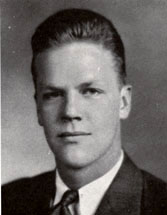|
Web Exclusives: More
By Richard A. Davis '47 The recent article "From Classroom to Battlefield, The Class of 1942 Remembers World War II," by Judge Charles B. Blackmar '42 (which appeared in the print version of PAW, December 6), poignantly suggests recognition of First Lieutenant Alexander "Sandy" Bonnyman, Jr. '32 USMC and the legacy of America's highest military decoration, the Medal of Honor. The heavily defended Betio Island in the Tarawa Atoll of the Gilbert Islands was initially attacked by three reinforced assault battalions of the U.S. Marine Corps Second Division on November 20, 1943. By nightfall 1,500 marines had been killed or wounded, and the outcome of this critical battle was in serious doubt. A banzai attack at the end of the first day would have destroyed the remaining marine landing forces. However during the second day, reinforcements of men and supplies slowly began to change the eventual outcome of the battle, as the marines held and enlarged their tenuous perimeter on Betio, whose total area approximated that of the Pentagon and its parking facilities. At dawn of the third and final day, the key to victory lay in the elimination of a massive and lethal Japanese concrete bombproof shelter that had halted the marine advance. Lieutenant Bonnyman, 33 years of age, was deferred from service by reason of occupation, but then enlisted, and was subsequently dismissed from the Air Corps for "buzzing too many control towers." After Pearl Harbor he was commissioned in the Marine Corps and volunteered in 1942 for the Guadalcanal campaign. On November 20, 1943 he was the executive officer of a shore party, a noncombatant assignment on Betio, but because of the battle's stalemate and increasing casualties, he advanced on his own initiative several hundred yards into the fiercely contested combat zone on Red Beach 3 near the formidable bombproof. He spent the next several hours studying the approaches to the giant, well-camouflaged bunker outlining his plan of attack to a group of hunkered-down marines. Bonnyman recognized the vulnerability of the several air vents on top of the seemingly impregnable bombproof, then led his 21-man assault team and destroyed its machine gun emplacements. His group was accompanied by a combat marine photographer, who recorded the hazardous climb of the sandy-sloped bunker, the systematic destruction of its defenses by flame-gunners, grenade, and rifle fire, and dropping short-fused TNT charges down the air vents, which flushed out 150 defenders, who were killed. The final segment from the cameraman-s 16-mm film shows Lieutenant Bonnyman kneeling at the top of the bombproof, firing into the enemy, and turning to wave forward other marines before he fell, mortally wounded. PAW in its "Line of Duty" of March 10, 1944 euphemistically reported in the patriotic spirit of the day, "Fatally wounded, Bonnyman turned around, smiled at his men and fell to the ground, dead." In fact, when Lieutenant Bonnyman was recovered by his men, he lay forward facing the enemy, identified only by his dog-tags. As a matter of record, it was neither essential for Alexander Bonnyman to be in the Armed Forces, nor in combat on Betio Island. However, his calculated ingenuity and extraordinary leadership of this assault that was critical to victory in one of the most violent and savage battles of the Pacific campaign during World War II, honored his country, the Marine Corps, his family and university. As Charles B. Blackmar '42 has reminded us in his splendid review of the dedication and service of his classmates during the second great war of the 20th century, a generation of thousands of young Americans made exceptional sacrifices to preserve the priceless heritage of our fragile, yet workable democracy. Richard A. Davis M.D. is the author of the World War II novel Yours D3 (1999). |
||

